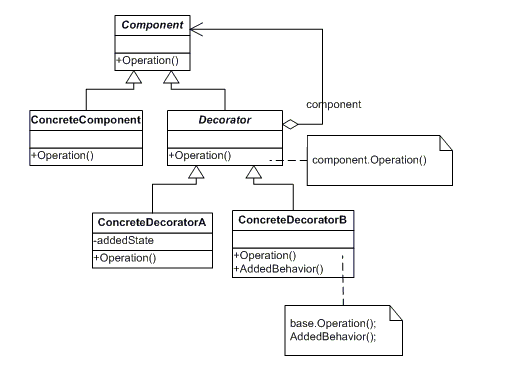装饰模式
装饰模式:
动态地给一个对象添加一些额外的职责,就增加功能来说,装饰模式比生成子类更加灵活
装饰类利用SetComponent来对对象进行包装,这样每个装饰对象的实现就和如何使用这个对象分离开了,每个装饰对象只关心自己的功能, 不需要关心如何被添加到对象链当中
装饰模式的优点:
简化原有的类,核心职责和非核心职责区分开来
UML类图

代码示例
按照UML类图,代码如下:
#include "stdafx.h"
#include <iostream>
using namespace std;
class Component
{
public:
virtual ~Component()
{
}
virtual void Operation()
{
cout << "Component::Operation" << endl;
}
};
class ConcreteComponent : public Component
{
public:
virtual ~ConcreteComponent()
{
}
virtual void Operation()
{
cout << "ConcreteComponent::Operation" << endl;
}
};
class Decorator : public Component
{
public:
Decorator()
{
m_pComponent = nullptr;
}
virtual ~Decorator()
{
}
void SetComponent(Component* pComponent)
{
m_pComponent = pComponent;
}
virtual void Operation()
{
if (nullptr == m_pComponent)
{
return;
}
m_pComponent->Operation();
cout << "Decorator::Operation" << endl;
}
protected:
Component* m_pComponent;
};
class ConcreteDecoratorA : public Decorator
{
public:
virtual void Operation()
{
Decorator::Operation();
cout << "ConcreteDecoratorA::Operation" << endl;
}
};
class ConcreteDecoratorB : public Decorator
{
public:
virtual void Operation()
{
Decorator::Operation();
cout << "ConcreteDecoratorB::Operation" << endl;
}
};
int main()
{
{
ConcreteComponent objConcreteComponent;
ConcreteDecoratorA objConcreteDecoratorA;
objConcreteDecoratorA.SetComponent(&objConcreteComponent);
ConcreteDecoratorB objConcreteDecoratorB;
objConcreteDecoratorB.SetComponent(&objConcreteDecoratorA);
objConcreteDecoratorB.Operation();
}
system("pause");
return 0;
}
输出:
ConcreteComponent::Operation
Decorator::Operation
ConcreteDecoratorA::Operation
Decorator::Operation
ConcreteDecoratorB::Operation